The city’s fixation on demolition and failure to embrace retrofit risks repeating the failed planning policies of the past, writes Joe Holyoak
Birmingham’s relentless urge to self-destruction carries on. The threat to James Roberts’ 1962 Smallbrook Ringway building is not yet resolved, and continues to occupy the headlines. The campaign group Save Smallbrook (of which I am a member) is now asking for a judicial review of the planning committee approval for redevelopment, on the basis that the carbon release consequences of the Ringway building’s demolition and redevelopment were not adequately taken into account in the decision. We await the judge’s ruling: meanwhile we crowdfund money to pay for the review.
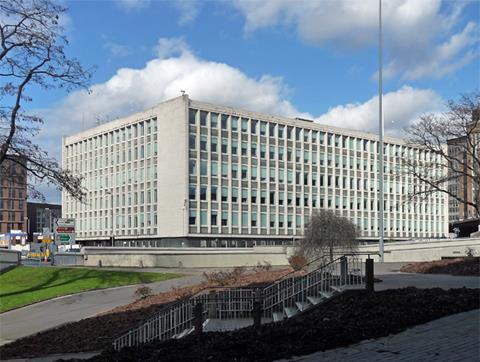
But across the city centre, another fine concrete building from the same period of architecture is also under threat. 1 Lancaster Circus was built in 1958, designed by architects J. Alfred Harper and Son, as headquarters for Halfords, retailer of motoring and cycling products. It occupies an entire street block, and its primary 60 metre-long, six-storey elevation addresses Lancaster Circus, the most complicated junction on the city’s now mostly-dismantled Inner Ring Road.
Underneath a large rotary, tunnels carry traffic to and from the A34 road to Walsall, and above the rotary a curving flyover takes traffic to and from the A38(M) and Spaghetti Junction. It all epitomises the car-mad city of the 1960s. The city council’s stated intention is to remove the three-level intersection and replace it with something more pedestrian-friendly, but as yet there is no specific proposal.
Between the A34 and the A38 sits 1 Lancaster Circus, a sober and urbane piece of modern street architecture. It just needs the streets to be put back in place. Halfords moved out to Redditch in 1971, and the building became the first and only home of the West Midlands County Council during that short pre-Thatcher period of metropolitan regional local government.
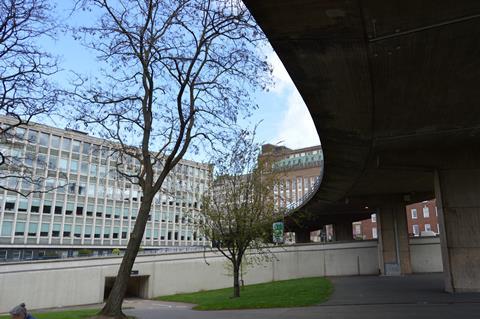
Birmingham City Council then took over the building, and it accommodated the planning and highways departments until, already under financial pressure, the council vacated the building in 2022, shrinking its office space post-Covid with more staff continuing to work from home. The building is in good physical condition, and could easily be converted to new economic uses: if necessary with the cutting of an atrium into its deep plan.
It is now owned by Sama Developments, which declares itself a Shariah-compliant developer, whatever that may mean for urban form. They propose its demolition and replacement by two freestanding towers of student accommodation. This is typical of the fragmentation of the city’s fabric which is taking place all over the city centre, and beyond.
Developers are encouraged to build high by the city council planners, as tall buildings are thought to convey civic and commercial prestige. There are people who support this misguided policy. I occasionally read online sites such as SkyscraperCity, whose subscribers are impressed by new tall buildings. They have an interest in architecture, but it appears to be limited to one dimension: their only criterion for good architectural design is height – if it’s tall, it’s good.
The existing 1 Lancaster Circus building is in the form of a street block which has the capacity to become a part of a restored street- and square-based urban pattern. The main southern elevation could successfully address a square of a similar dimension, which might replace the present highway jungle.
Across the flyover is another fine building designed to address streets, the 1935 Central Fire Station, listed Grade II, and successfully converted into student accommodation by Bob Ghosh’s former practice, Kinetic. It is the triangular perimeter block in the foreground of Sama Developments’ aerial perspective. It provides a model for what should happen to its neighbour 1 Lancaster Circus.
>> Also read: Birmingham’s tall buildings policy is in danger of becoming a free-for-all
Instead, we have a proposal which would destroy a sound and reusable modern building, with all the carbon-release consequences in contravention of Birmingham’s towards-net-zero policy: a building which has the capacity to be part of a civilised street-based fabric.
This kind of fabric is promoted in the current central area strategy document Our Future City, which I have written about in BD previously. It proposes that Birmingham should become more like European cities such as Lyon, Brussels and Budapest. The central areas of these cities have a predominantly street-and-block mid-rise fabric of around six storeys (the height of 1 Lancaster Circus). They are also relatively free of high-rise towers, and are popular places to live.
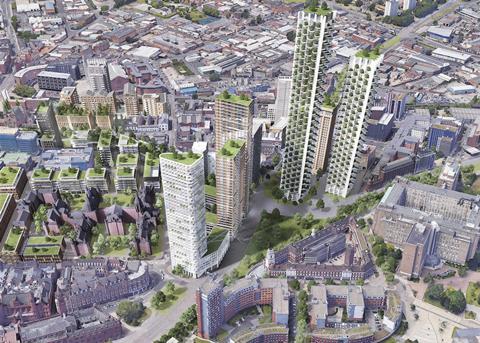
But Our Future City at the same time contradicts itself by including absurd CGIs showing isolated high-rise buildings emerging from jungles of trees: like surreal fragments of Le Corbusier’s La Ville Radieuse, but one hundred years too late. One of the CGIs in fact shows a future Lancaster Circus, and in place of the existing no.1 building appear… two towers standing among trees.
Each of the CGIs is carefully captioned “This concept image is an artist’s impression to stimulate discussion. It does not represent a fixed proposal or plan”. This disclaimer is disingenuous. Why would you include imaginary pictures of parts of the city in a policy document if you did not want them to be seen as illustrating the planners’ preferred vision?
Sama Developments and their architects Stride Treglown have taken the picture literally, and reproduced it in the form of a development proposal, perhaps understandably. But it is a picture of a utopian city of the future, 100 years old, which 50 years ago was demonstrated not to work. It’s a bankrupt vision.
>> Also read: Policy Exchange report says ‘mania’ for high rise development has damaged UK cities
>> Also read: Is Birmingham’s vision for a greener, high-density city centre achievable?









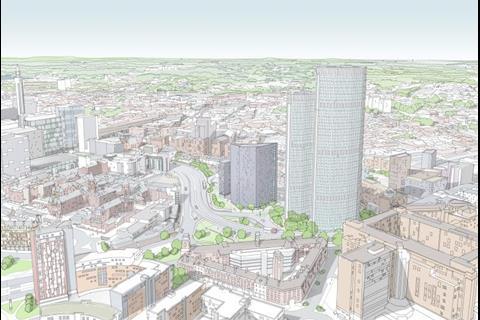
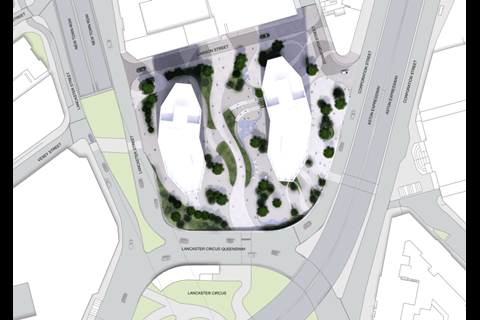







2 Readers' comments